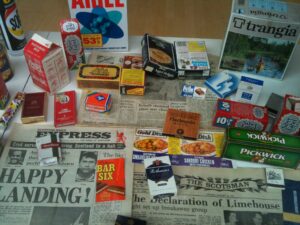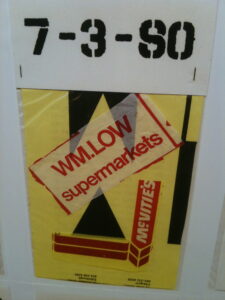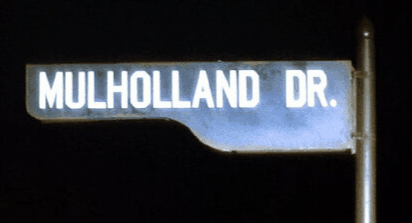
Every day, for a period of ten years, Pete Horobin would document his activities on an A4 sheet. While the format changed annually, the DATA stencil and the A4 format remained the same integral part of his routine.
The research-based format allowed Horobin flexibility. The project could travel with him since it required little in the way of resources. For a studio he required only some A4 DATA sheets and a pen and, for his sources, an awareness and remembrance of his own daily activities. The project was a simple declaration of being alive. But it is a very particular declaration, one of being alive in Scotland, and of working, predominately, in Dundee during the Thatcher era. As such, it is both a document of Horobin’s personal life, his social and cultural activities, and of the shifting habitus in which they took place.
The project is gargantuan in its scope and attention to detail, and yet perfectly ordinary. Horobin’s life over a decade forms the subject matter of the project, but, as with all of us, Horobin had no essential properties, no fixed state of being. We might think of Horobin and the DATA project as a transparent assemblage of form and field, a configuration of resources and the contexts in which they are found. The resources are varied and always integrated into Horobin’s holistic experience. If only for the purposes of thinking about their assemblage, it helps to consider just a few constituent resources: Food, Media,
Networks and Spaces.
Contexts are equally varied. For Horobin, Scotland formed an immediate site in which he lived and worked. We can situate ‘Scotland’ in the microcosm of Horobin’s living and working spaces (The Attic, the countryside, the city, the network) as well as the developing macrocosm of the cultural and political environment (post-Fordism, energy crisis, Thatcherism, cultural paternalism.)
Context: Economy
The early days of the DATA project are scarred by the context of political and economic crises of the period. The 1980 DATA sheets show that Horobin was working at the Dundee office of Conoco North Sea Inc, an oil company based in Houston, Texas. An advantage of working at Conoco was that it provided Horobin with a valuable insight into what was going on in the North Sea industry at that time – a politically charged context that has particular resonance with Scotland’s present position in relation to a minority Tory government in Westminster. Horobin’s temporary employment followed hot on the heels of the failed devolution bill and the election of the Thatcher government. Both events sealed the fate of North Sea gas and oil and Scotland for the next 20 years, locking the state into poorly negotiated deals that took as much energy revenue out of the local economy as possible.
Horobin’s DATA sheets reveal the huge mistakes made in Scotland when negotiating with the big oil companies. Only the Shetlanders, who successfully negotiated direct disruption payments for construction of the Sullom Voe terminal, were able to channel money into local services such as museums, art and ferry subsidies. The Dundee base of Conoco was seen as a curse for the mainly American staff. Like most US firms, Aberdeen was seen as a preferable base for their employees working on an oil production project at Murchison near Shetland. All the top oil jobs in Scotland went to Americans, there was no training in Scotland that would have prepared Scots to take on the big jobs in North Sea Oil, so it was open field for migrant labour from the US Energy Corridor.
Context: Environment
Horobin spent a great deal of his time in Dundee working, socialising or at home in The Attic. The routine of this life is broken in the DATA archive by temporarily relocating to other cities: Paris (Cairn), Milan, Newcastle (The Basement), London (in May 1984 DATA was situated in 13 Aulton Place, Kennington, where it formed part of the 8th Neoist Apartment Festival, a week of concentrated activities), Ponte Nossa (9th Neoist Apartment Festival at Emilio Morandi’s Arte Studio), Glasgow, (The Festival of Non-Participation)….. In his urban travels, Horobin connects and collaborates first hand with his corespondents in their own environments.
27-12-80 ‘Paris is a facade. The children and dogs accept it as so.’
Much of Horobin’s time is spent in the countryside, becoming ‘a tourist in my own country’, travelling around Scotland, climbing mountains and documenting the pilgrimage. In 1989, the Year of the TENT, Horobin decided to spend the entire 12 months outdoors, camping in various locations. The TENT sheets return us in some senses to the early days of the DATA project, the enforcement of a solitary life generating a greater sense of focus for a heightened self-awareness in each daily entry. There’s no question of this experience being more authentic than the ‘facade’ of the city. The countryside simply offered Horobin a different type of ‘irritant’:
… to create an organism that is constantly seeking for irritation. […] The
irritation of the organism is applied in three different directions:
(a) towards the social relationship of the individual to his environment;
(b) towards the limitations implied in material situations;
(c) towards conceptual possibilities, the physical embodiment of which is unimportant.1
Roy Ascott’s learning device of the ‘irritant’ is a behaviourist strategy for engaging creatively with ‘everyday’ environments that is relevant to Horobin’s work. It dramatises what is otherwise held to be the sphere of ‘naturalised’ practice, where practice is a habit, an accumulation of knowledge in tactic form. If, to follow Ascott’s terms, Horobin’s organism was his life, the irritant was the environment in which his life was lived. Horobin’s social relationship to his physical and material environment would always impose limitations upon his possibilities as an artist. A varied and challenging environment might produce a richer and more complex ‘practice.’ An ongoing, self-conscious examination of nature and the environment, then, is a prevailing preoccupation throughout DATA. DATA is a kind of organism in its own right, a self-regulating system that evolves in relation to the flexible parameters and indeterminate environments that Horobin encountered.
Resources: Food
The most basic resource required by an artist perhaps, DATA shows a consistent preoccupation with food, with what goes into (and what comes out of) the body. The 1980 sheets dwell upon convenience foods – popcorn, chocolate bars, snacks, tinned goods – as well as more wholesome home cooking – a recipe for rabbit stew, daily documentation of campfire cooking. While this may smack of recreational consumerism, it has a more basic function, animal laborans. Harvesting and consuming food is a cyclical process, an essential resource, no food = no Horobin. This extends to drinking and smoking, the ephemera of which are extensively documented in DATA photographs. No distinction is made by Horobin between biological and technological forms of information here, between the raw and the cooked. This aspect of DATA as an unedited ‘flow’ extends from an earlier project ‘Art into Junk’, a povera-esque fixation with the flotsam and jetsam of the consumer economy, with the found object as situated in manifold actions.
Resources: Life
In documenting his daily existence, DATA transformed Horobin’s behaviour into his practice, generating a process rather than a product. In places, his reality appears to be structured like fiction. In a number of entries he considers a series of unscripted actions, imagining his life playing out in a cinematic fashion, with himself as ‘principal player’. In constructing and fictionalising his own subjectivity the early entries in the DATA archive show this hypothesis taking seed, developing an idea that resembles the theory of ‘agencement’ developed by Delueze and Guattari (2) and elaborated by actor-networktheorists (3) contemporaneously in the early 1980s. Horobin presents himself as forming part of an agencement, a hybrid collective or assemblage of human relationships, tools and physical surroundings. DATA records Horobin, an actor of no fixed ontology, as explicitly dependent upon a mutually constitutive network of humans and non-human actors. The parameters of this network were determined by the actors who scripted it, while the actions of these human actors was determined by the agency of the network. The feedback loop was a self-adjusting script, it simply required frequent input of
communication.
In DATA, the Horobin actor is scripted from personal experience to produce an identity that can be performed at a later date. In this, Horobin’s documentation of his own life formed a play in which others might star, adopting his persona and mores to be played out by other actors in different ways. This implication is that this might enable an ego-less cultural practice to emerge, or, more accurately, allow users of the DATA archive to simulate alterity. This contribution to the agencement is perhaps better known in mail art and neoist circles as the ‘multiple name’, an idea that would manifest itself most visibly in the collective identity magazine Smile, of which Horobin was one of many anonymous contributing editors.
Resources: Media
Horobin’s media changed very little in the 10 year period of the DATA project. In archiving his existence, paper, pen, camera, audio cassette, VHS video and photocopier form the mainstay for the bulk of the project.
The DATA sheets show Horobin making use of the limited facilities that Dundee had to offer in the ‘80s, joining the Seagate Printworks (27-10-80 Membership £5), using the local art school’s photography studios and student bar. Much of the photography is in black and white in the early DATA period, only later does Horobin use colour photography as cheaper methods of printing became more readily available. The early DATA sheets show images of objects in Horobin’s flat: shoes, worn out slippers, clothes, nail clippings…. and of his routines: washing, smoking and eating mainly. A few of the photographs were developed at Duncan of Jordanstone College of Art & Design, but most at the now long-gone Dudhope Arts Centre, and most were done without the use of a darkroom. Horobin’s lesson in resourcefulness came from Inuit photographers who documented their nomadic lifestyle in this fashion.
For Horobin, the key advantage of working at Conoco was gaining free access to a photocopier – the medium of choice for artists in 1980. Horobin would arrive early at Conoco and use the copier to generate issues of the DATA sheets for monthly publication – a form of involuntary simplicity that emerged straight out of Scotland’s punk zine scene of the late 70s. Since they were part of his daily practice, his agencement, he also made use of Conoco stationary and memos in his DATA sheets.
DATA was distributed to a mailing list compiled by Hoborin comprising of galleries, artists, critics and magazines. Perhaps the key resource here, one referred to Horobin as a ‘media’, was the GPO. Without the Post Office, Horobin would not have had an audience for his work. It was the vital ingredient that connected his ideas with those of his network, the link that opened up his private existence to a much wider community of interest.
Resources: The Network
Long before blogging become commonplace (4), the GPO was the network for Horobin’s correspondence. While most of this correspondence is archived in Budapest and is not the subject of this exhibition, it is evidenced in the DATA sheets, in the recording of ‘mail in’ and’ ‘mail out’ or in Horobin’s reflections upon letters he has written or received. No hierarchy exists in terms of Horobin’s exchanges, letters to his mother, gas bills and Giros are all documented as forming part of this network of correspondence. The flow and feedback of all information is paramount at all times.
In the late 1970s, Horobin became involved with an artists collective in Paris called Cairn, who added him to their mailing list. One of the first recipients of the monthly self-published DATA in 1980 was Cairn and as a consequence of this postal exchange, Peter Below, another artist on Cairn’s mailing list, quickly made contact, followed by Robin Crozier who had corresponded with Below since the 1970s. However, mail art was never Horobin’s chosen context – his practice was concentrated on the habits and rituals of everyday life: getting up, going to work, socialising, creating, and sleeping – more often than not in this precise order. Horobin copied and distributed his correspondence daily via the mail art network. Lots of artists with a broader practice came into the network this way, re-performing both their own agency and the configuration of the network itself. The network didn’t relate to the mainstream Scottish art world of the time – it was a resource unto itself and independent of state or private cultural resources.
The DATA archive shows this network slowly opening up to Horobin, making DATA increasingly internationally connected, connecting with neoists and correspondence artists including Robin Crozier, Stewart Home, tENTATIVELY a cONVENIENCE, David Zack, Istvan Kantor, Monty Cantsin, Carlo Pittore, Mark Pawson, Louise Crawford and Vittore Baroni, among others.
The network enabled Horobin’s connection with neoism. In June 1982, he hitchhiked to the 1st European Neoist Network Training Camp organised by Peter Below in Studio ‘58, Wurzburg, Germany. Horobin performed and documented the event which was published as an A4 book by Peter Below and Istvan Cantor. By this time David Zack had established the ‘Immortality Centre’ as an HQ in Tepoztlan, Mexico. People could gather there to engage in projects such as adobe building, and Zack would install mailed art works in the locale, such as the local barbers. The Immortality Centre became a model for how Horobin would develop his other vital resource: The Attic.
Resources: The Attic
For much of the DATA project, The Attic in Dundee, Horobin’s home and studio on the top floor of 37 Union Street, was host. Horobin bought the top floor flat in 1980 when it was in a semi-derelict state. It took him five years to negotiate a new roof for the space. For Horobin, a studio was an expensive luxury that few artists could then afford. Temporary work and unemployment were increasingly the norm for artists in the ‘80s and so it was pertinent to work in a way that was flexible and liberating, that required little in the way of expensive equipment and as few resources as possible.
The Attic was a site for Horobin to engage in his work, corresponding with other artists who formed part of his network – including a growing network of neoists – while hosting guests who would come to collaborate and correspond in his living quarters. From the mid ‘80s, the flat hosted to a growing number of visitors drawn from his expanding network of correspondents, including Karen Strang from Bigos – an Anglo- Polish collective of artists formed by Stefan Szczelkun – Louis Crawford, Variant, Stewart Home and David Zack. The Attic was an ongoing Apartment Festival. In turn, The Attic became a production and distribution centre for editions of the multiple-identity publication SMILE.

Resources: DATA
At the end of the 10 year DATA project, Pete Horobin ceased to exist as a creative entity. DATA survives as a series of viable scripts. The archive was retained as a resource – a gift for others to use. A score of a life for other lives, DATA is a catalyst of great potential.
References:
FOOTNOTES / REFERENCES
1 Roy Ascott, Groundcourse Prospectus, Ealing College of Art, 1963-4 in Ascott and Edward A. Shanken (eds).
Telematic Embrace: Visionary Theories of Art, Technology, and Consciousness, University of California Press, 2007,
p155.
2 Mille Plateaux, 1980.
3 Callon, Michel, and Bruno Latour. 1981. ‘Unscrewing the Big Leviathan: How Actors Macro-Structure Reality and How
Sociologists Help Them to do So’, p. 277-303 in Advances in Social Theory and Methodology: Toward an Integration of
Micro- and Macro-Sociologies, edited by Karin Knorr Cetina and A.V. Cicourel. Boston: Routledge and Kegan Paul.
4 The WELL dial-up bullentin board did not start until 1985. Although it emerged from a drop-out Californian Ideology of
self-determination rather than from a history of the avant-garde, Howard Rheingold’s account of the Virtual Community
that developed online via the WELL corresponds structurally with the mail art network’s expanding communties of
practice.
——
A minigraph article by published to coincide with the Gi show
DATA – Daily Action Time Archive
A self-historification project by Pete Horobin
Until – 3rd June 2012




